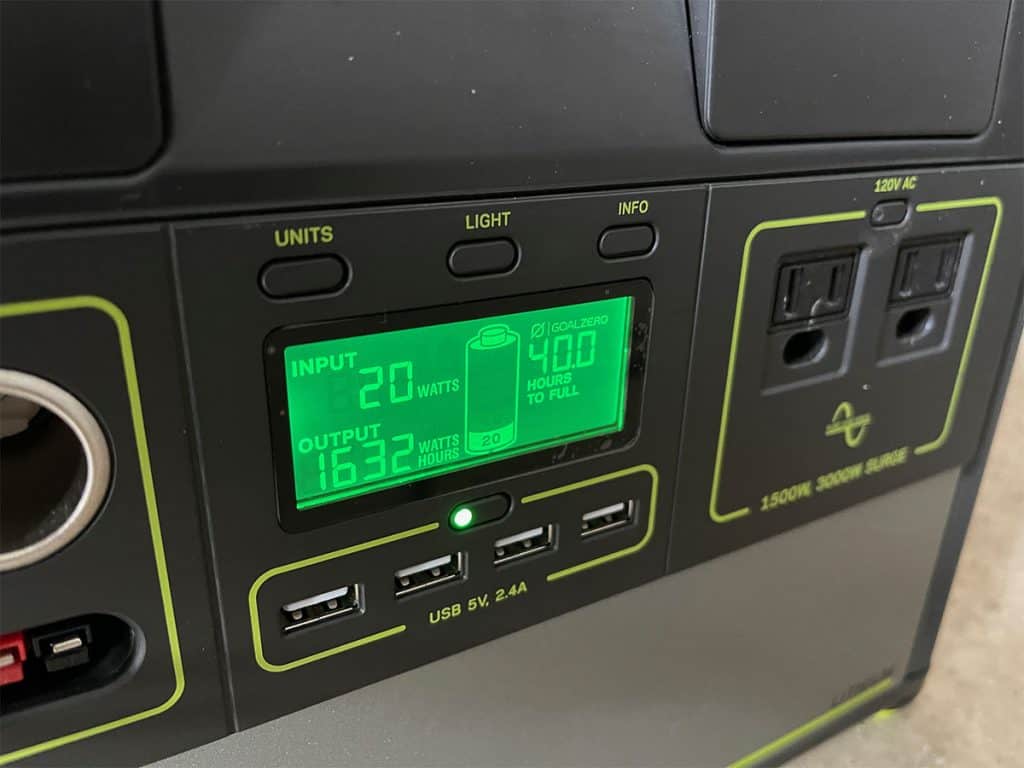As our dependence on electronic devices continues to grow, portable power solutions are becoming increasingly important. The Goal Zero Yeti 1000 is a high-capacity portable power station designed to provide power for a wide range of devices, from small electronics like phones and tablets to larger devices like laptops and even some home appliances. In this review, we will examine the features of the Goal Zero Yeti 1000, including its limitations around amperage draw and the industry cycle charge, which may make you want to pass on this brand and look at some of their competitors.
Features
The Goal Zero Yeti 1000 is a portable power station that can be recharged in a number of ways, including solar panels, AC power, and 12V car charging. It has a lithium-ion battery with a capacity of 1045Wh (or 96,800mAh at 10.8V). This is enough to power a laptop for up to 12 hours, a mini fridge for up to 17 hours, and a TV for up to 10 hours, depending on the device and the load. The Yeti 1000 has a number of ports for charging and powering devices, including:
- 2 USB-A ports (5V, up to 2.4A)
- 2 USB-C ports (5V, up to 3A)
- 2 AC outlets (110V, 10A, 1200W surge)
- 2 6mm ports (12V, up to 10A)
- 1 12V car port (up to 10A)

This variety of ports makes it easy to charge and power a wide range of devices, from phones and tablets to larger appliances and power tools. The Yeti 1000 also has a built-in MPPT charge controller, which allows it to be charged more efficiently from solar panels.
Limitations
While the Goal Zero Yeti 1000 is a powerful and versatile portable power station, it does have some limitations that should be considered before purchasing. One limitation is the amperage draw of the AC outlets. While the Yeti 1000 can provide a surge of up to 1200W to power devices like mini fridges and power tools, the maximum continuous output from the AC outlets is 1000W. This means that if you are using the AC outlets to power devices that draw more than 1000W, the Yeti 1000 may not be able to keep up with the demand. While the Yeti 1000 might be able to handle the draw of some smaller miter saws, it will trip immediately for larger ones such as the Dewalt double-bevel miter saws.
Another limitation of the Yeti 1000 is its cycle charge. The cycle charge is the number of times the battery can be fully charged and discharged before it starts to lose capacity. The Yeti 1000 has a cycle charge of around 500, which is lower than some of its competitors. This means that if you are using the Yeti 1000 frequently and fully discharging the battery, it may start to lose capacity after a few years of use.
Competitors
While the Goal Zero Yeti 1000 is a solid portable power station, there are a number of competitors on the market that may offer better value for your needs. One competitor is the Jackery Explorer 1000, which has a slightly lower capacity than the Yeti 1000 (1002Wh), but has a higher continuous output from the AC outlets (1000W). The Explorer 1000 also has a higher cycle charge of around 1000, which means it may last longer with frequent use.
Another competitor is the EcoFlow Delta 1300, which has a higher capacity than the Yeti 1000 (1260Wh), a higher continuous output from the AC outlets (1800W), and a higher cycle charge of around 800.
The Delta 1300 also has a unique feature called X-Boost, which allows it to provide up to 1800W of continuous power to devices that require a higher surge than their continuous output. This makes the Delta 1300 a good option for powering appliances like refrigerators and power tools.
Conclusion
The Goal Zero Yeti 1000 is a powerful and versatile portable power station that can provide power for a wide range of devices. Its variety of ports and recharge options make it easy to use, and its built-in MPPT charge controller allows it to be charged more efficiently from solar panels. However, the Yeti 1000 does have some limitations around amperage draw and cycle charge that should be considered before purchasing.
If you are looking for a portable power station with a higher continuous output from the AC outlets and a higher cycle charge, the Jackery Explorer 1000 or the EcoFlow Delta 1300 may be better options. The Delta 1300 also has the added benefit of the X-Boost feature, which can provide extra power to devices that require a higher surge than their continuous output.
Ultimately, the choice of which portable power station to purchase will depend on your individual needs and priorities. If you value the Goal Zero brand and the Yeti 1000’s features fit your needs, it can still be a solid choice. However, it’s important to consider all of your options before making a decision to ensure that you get the best value for your money.

